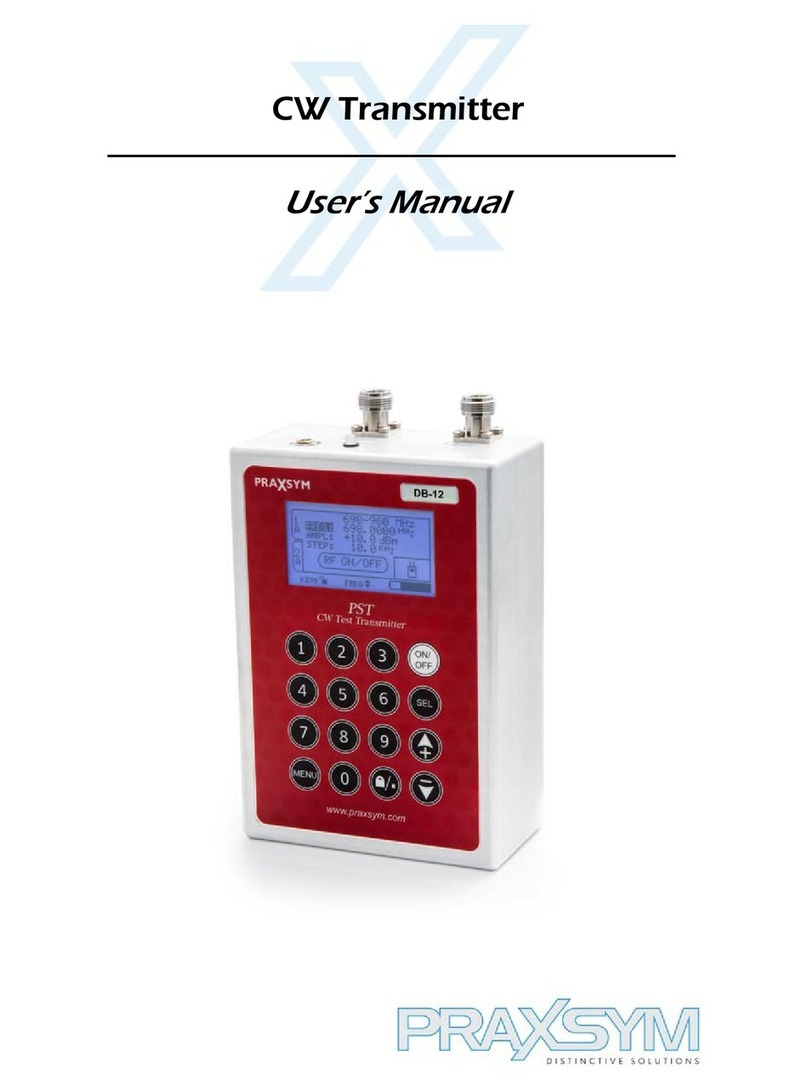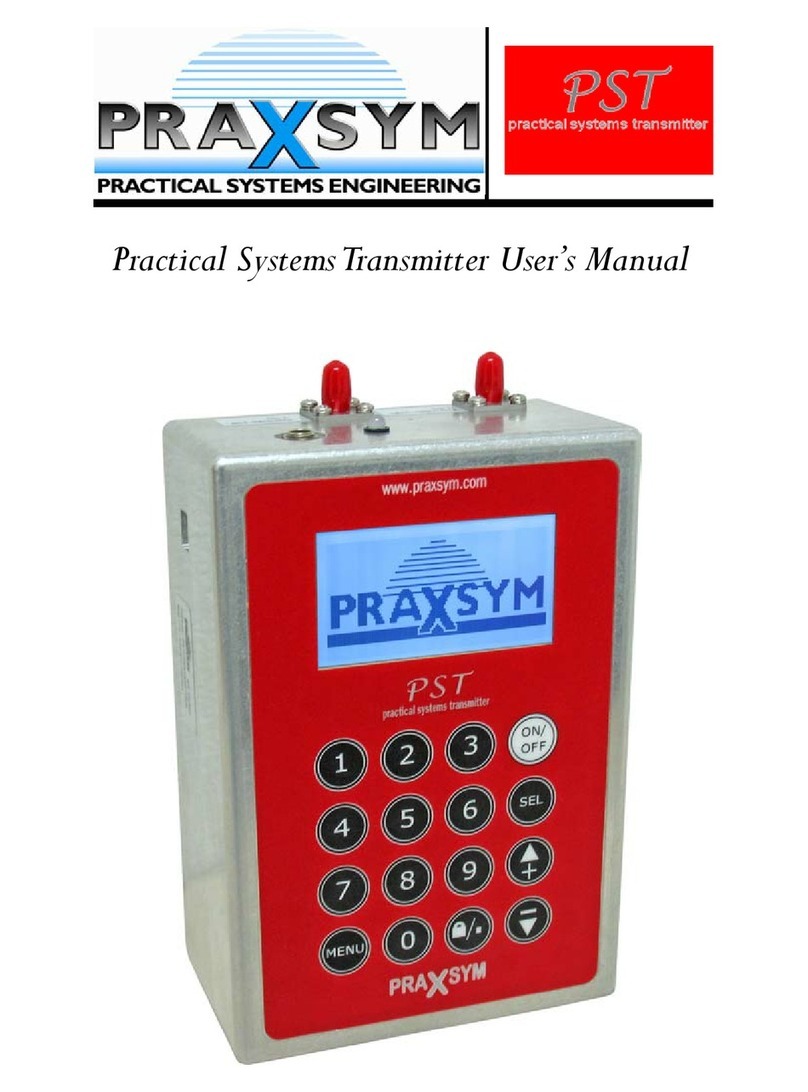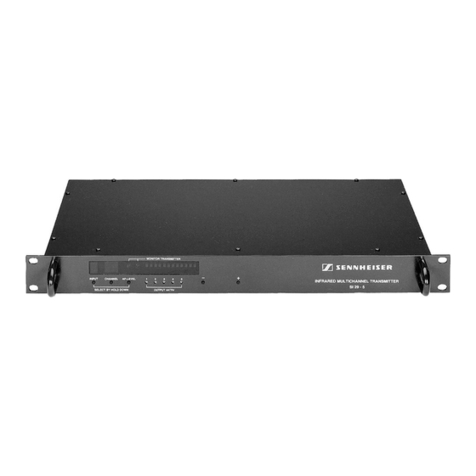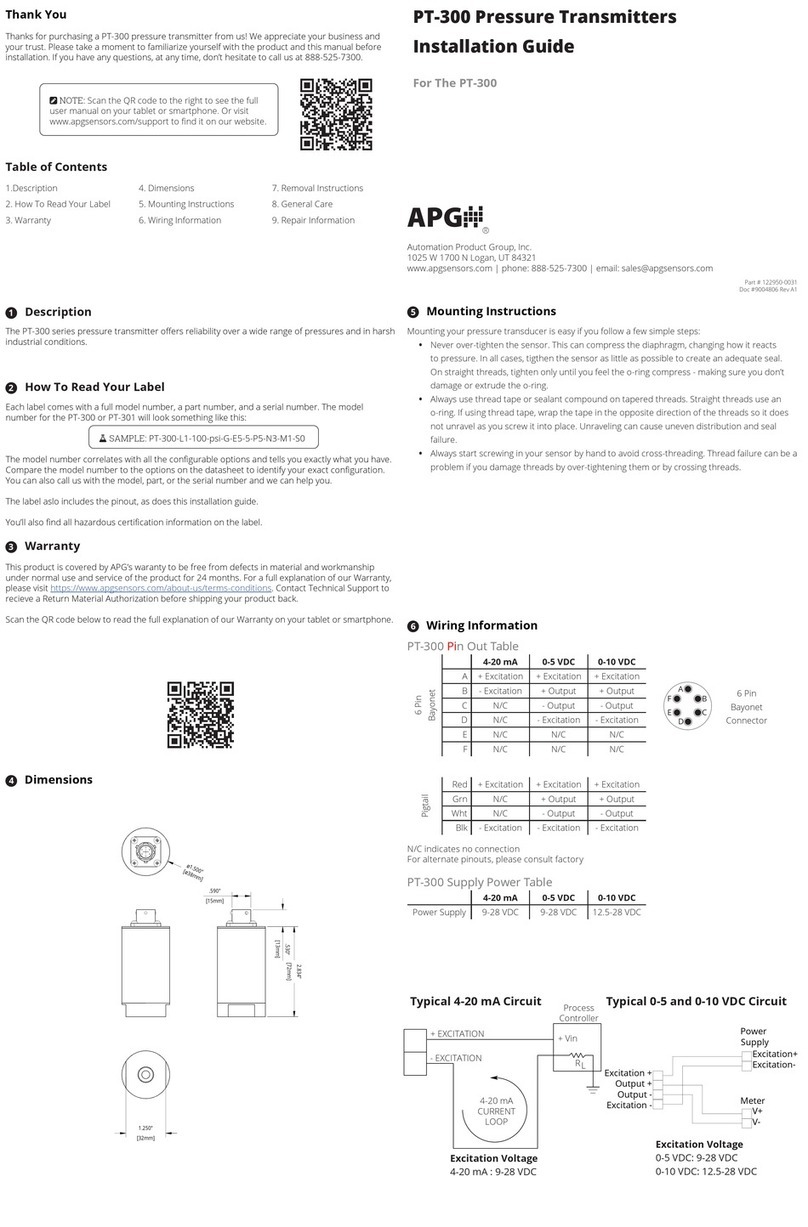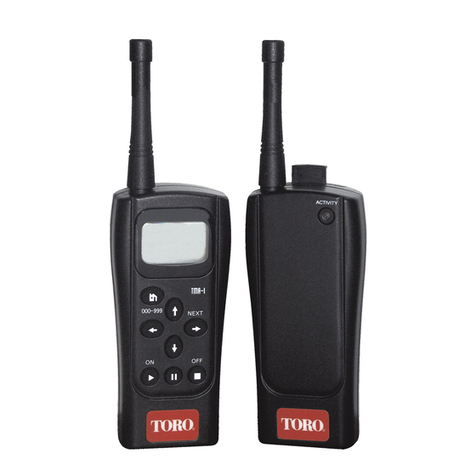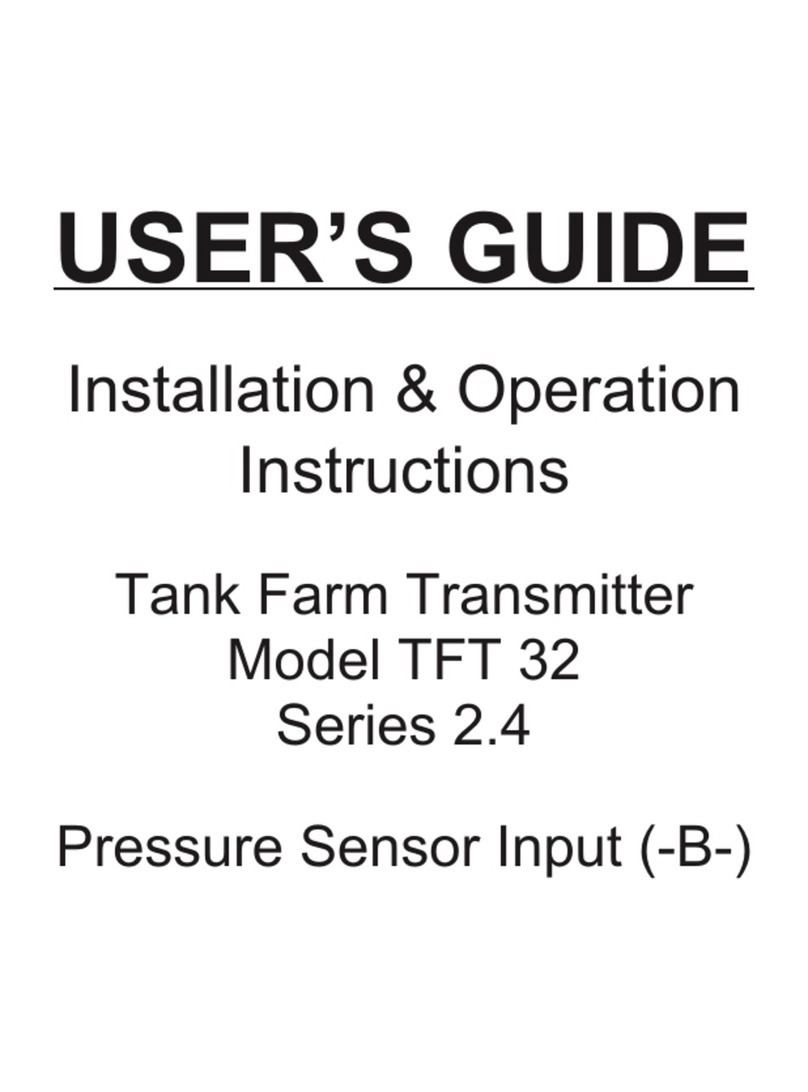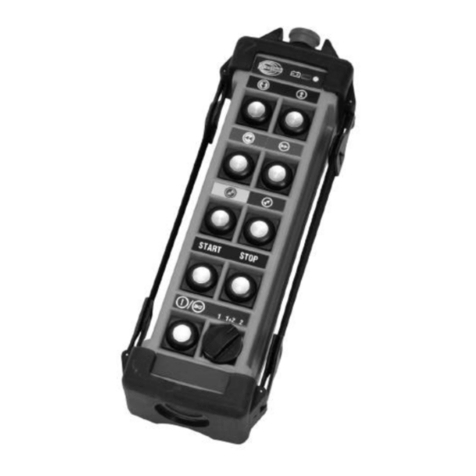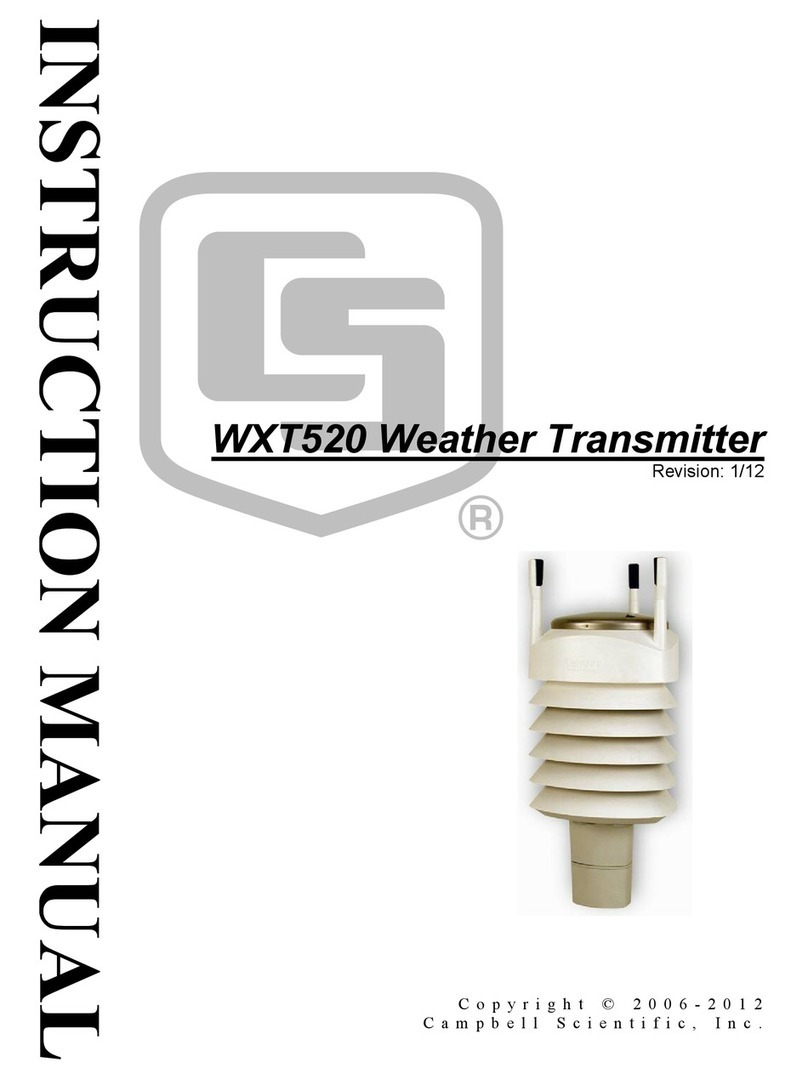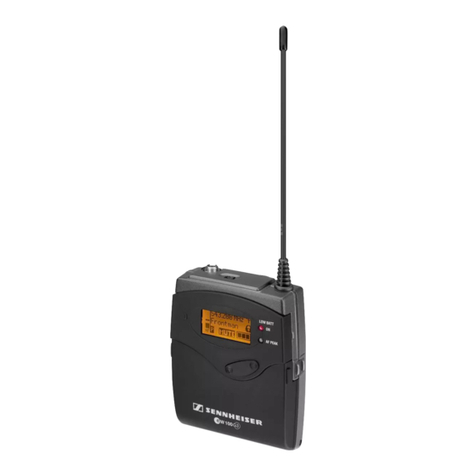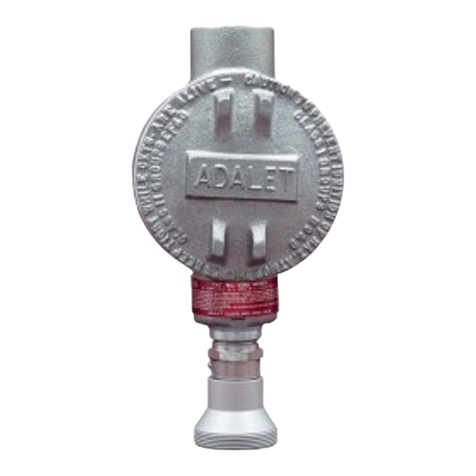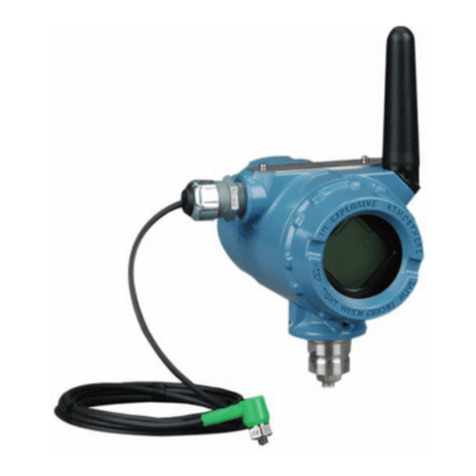PRAXSYM PathTrax Series User manual

User’s Manual
The solution for making easy shielding effectiveness
measurements.
PathTrax

TABLE OF CONTENTS
Chapter 1 General Information 2
Introduction
Specifications
Receiver
Transmitter
Chapter 2 Controls and Connections 6
Receiver
Transmitter
Chapter 3 Operation 8
Chapter 4 Remote Operation 16
User Commands
Installing the USB-Serial Driver
Warranty Statement
PRAXSYM warrants that all items will be free from defects in material and
workmanship under use as specified in this guide for a period of one year
from date of delivery. PRAXSYM further agrees to repair or replace, at its
discretion, any failure which upon PRAXSYM's inspection appears to be a
result of workmanship or material defect. In no case, shall PRAXSYM's liability
for breach of warranty exceed the purchase price of the items in question.
PRAXSYM's liability on any claim of any kind, for any loss connected with, or
resulting from the use of, performance or breach thereof, installation,
inspection, operation or use of any equipment furnished by PRAXSYM, shall in
no case exceed the purchase price of the goods which give rise to the claim.
Praxsym, Inc.
120 S. Third Street
Fisher, IL 61843
P: 217-897-1744
www.praxsym.com
Page 1

Page 2
PRAXSYM
Chapter 1 General Information
Introduction
PathTrax is a user-friendly microprocessor-based transmitter and
receiver system that measures relative signal strength, path loss and
shield level. The units are powered by rechargeable batteries for up
to 4 hours of continuous operation (2 hours for the transmitter). The
battery charging circuitry allows full recharge in 90 minutes or less.
The large backlit LCD screen provides numeric as well as graphic
representation of signal levels. Operation is via top mounted
controls or through the USB port provided. Complete control of the
unit’s operation can be accomplished via the serial port, with the
exception of power ON/OFF and receiver volume. Measurement
data can be transferred to a portable computer for later analysis.
Equipment List
Transmitter
Receiver
Hard Shell Case
USB Patch Cable
User’s Manual
Driver CD
Two Power Supplies
Two Antennas
32 Stereo ΩHeadphones
Safety/Handling
The PathTrax system has been designed to survive in-field usage,
however the following handling restrictions should be observed:
Protect the units from electrostatic discharge.
Do not connect high power (>10 mW) RF sources to the RF
connectors.
Do not connect DC sources to the RF connectors.

Specifications
All models of the PathTrax line share the same specifications except
for the operating frequency. The frequency ranges for these models
are listed below:
Pathtrax 915 covers 885 to 960 MHz
Pathtrax 860 covers 824 to 900 MHz
Pathtrax 838 covers 806 to 870 MHz
Pathtrax 500 covers 489 to 512 MHz
Receiver
Tuning Step Size: 1 MHz, 100 kHz and 10 kHz
Operating Modes: Signal Strength, Spectrum Monitor,
Path Loss, Shield Level
IF Bandwidth: 15 kHz nominal
1st IF: 90 MHz
2nd IF: 450 kHz
RF Input Connector: TNC Female (BNC on Pathrax 500)
RF Input Impedance: 50 Ωnominal
Input Preselection: 4 pole Chebychev, 80 MHz 1 dB
bandwidth
Measurement Accuracy: +/- 1.0 dB (-110 dBm to 0 dBm)
+/- 2.0 dB (-120 dBm to -110 dBm)
Maximum Safe Input Level: +10 dBm (10 mW) minimum
Battery Operation: 4 hours minimum at full charge
AC/Charger Operation: 95-265 VAC, 48-65 Hz
Page 3

Charge Time: 90 minutes typical
Remote Operation: via USB interface
I/O Connectors: 5-pin, mini-USB, type B connector
Controllable Functions: All functions except ON/OFF/Volume
Output Data: All measurement data and instrument
status
Reading Rate: 500 ms (step tuning frequency and read
data)
Controls: ON/OFF/VOLUME, FREQUENCY TUNE,
COARSE/FINE, THOLD (sets threshold for
go/no-go testing), LOCK (locks out control
panel), MODE (SIGNAL STRENGTH,
SPECTRUM MONITOR, PATH LOSS, and
SHIELD LEVEL) and CAL (provides path
loss or shielding reference level normaliza
tion)
LED Indicators: BATTERY OVERTEMP, BATTERY CHARGE,
BATTERY FAULT
LCD Displayed Functions: Frequency, Battery Level, Mode (Signal
Strength, Spectrum Monitor Path Loss and
Shield Level), CAL Status, LOCK Status,
Frequency Adjust Status (Coarse or Fine)
Weight: 5.5 lb. Nominal
Case Size: 11.7”H x 5.1”D x 4.9”W
Page 4
PRAXSYM

Transmitter
Tuning Step Size: 1 MHz, 100 kHz and 10 kHz
Maximum Output Power:+30 dBm nominal (1 Watt)
Output Power Control: 1 dB steps from –30 to +30 dBm
Output Level Accuracy: +/- 1.0 dB maximum over Temp and Fre-
quency
Harmonics: -50 dBc typical
Output Impedance: 50 Ωnominal
Load VSWR: Safe operation into infinite VSWR
RF Output Connector: TNC Female (BNC on Pathtrax 500)
Battery Operation: 2 hours minimum at full charge
Batteries: Nickel Cadmium 9.6V @ 1800 mAh
AC/Charger Operation: 95-265 VAC, 48-65 Hz
Charge Time: 90 minutes typical
Remote Operation: via USB interface
I/O Connectors: 5-pin, mini-USB, type B connector
Controllable Functions: All functions except ON/OFF
Output Data: Instrument Status
Reading Rate: 500 ms (step tuning frequency)
Weight: 5.5 lb. Nominal
Case Size: 11.7”H x 5.1”D x 4.9”W
Page 5

Chapter 2 Controls and Connections
Receiver
FREQUENCY – F.DIGIT – The frequency select knob operates in
conjunction with the F.DIGIT button. Pressing the F.DIGIT
button toggles the step size between 10 kHz, 100 kHz, and 1
MHz. The current step size is displayed on the FRQ ADJ line of
the display. Turning the knob clockwise increases the frequency
by the selected step size. Counter-clockwise rotation decreases
the frequency by the selected step size.
MODE – The Mode button toggles the receiver between Signal
Strength, Spectrum Monitor, Path Loss and Shield Level. The
current mode is always displayed on the LCD screen. Press the
Mode button until the desired mode of operation is displayed.
CAL – When setting up the unit for Path Loss or Shield Level
measurements, pressing this button initiates the internal System
Calibration sequence. (See OPERATION section for details)
THOLD – These two buttons increment the threshold value up or
down. The value is displayed on the LCD. This is the signal level
at which the audible alarm is triggered.
LIGHT – This button activates the backlighting for the LCD display.
LOCK - The lock button toggles on and off to lock the control panel,
in order to guard against accidental changes during a
measurement. The status of the lock function is displayed on the
LCD screen.
POWER ON/OFF/VOLUME – Turn the control clockwise to power ON
the unit and counter-clockwise to turn it off. The volume control
changes the audio level for the alarm output.
PHONES – This is the audio jack for the threshold tone output. The
supplied headphones can be plugged into this output jack.
INPUT – RF Input connector (50 OHM)
REMOTE – This is the USB connection port. (See the section on
remote operation for details on this connection.)
Page 6
PRAXSYM

Transmitter
FREQUENCY – F.DIGIT – The frequency select knob operates in
conjunction with the F.DIGIT button. Pressing the F.DIGIT button
toggles the step size between 10 kHz, 100 kHz, and 1 MHz. The
current step size is displayed on the FRQ ADJ line of the display.
Turning the knob clockwise increases the frequency by the selected
step size. Counter-clockwise rotation decreases the frequency by the
selected step size.
MODE – The mode button toggles the unit between FREQ and
ATTEN. The current mode is displayed on the MODE line of the
display. When in the Frequency mode, the FREQUENCY select
knob steps the frequency as set by the F.DIGIT button. When in
the Attenuator mode, the FREQUENCY select knob steps the
output level as set by the F.DIGIT button.
ATTEN – Pressing the ATTEN button changes the power output level
in 10 dB steps, from 30 to +30 dBm. The current power level is
displayed on the LCD screen. Press the ATTEN button until the
desired output power is displayed. When the MODE is set to the
ATTEN then the FREQUENCY select knob will change the output
power in 1, 2, or 5 dB steps selected by the F.DIGIT button.
LIGHT – This button activates the backlighting for the LCD display.
LOCK – The lock button toggles on and off to lock the control panel
in order to guard against accidental changes during a
measurement. The status of the lock function is displayed on the
LCD screen.
POWER – This is a rotary ON/OFF switch. Rotate clockwise to turn
ON, rotate counter-clockwise to turn OFF.
OUTPUT – RF output connector (50 OHM)
REMOTE – This is the USB connection port. (See section on remote
operation for details on this connection.)
Page 7

Chapter 3 Operation
Receiver Modes
The receiver has four different modes. Pressing the MODE button
will cycle through SIGNAL STRENGTH, SPECTRUM MONITOR, PATH
LOSS, and SHIELD LEVEL modes. The selected mode of operation is
shown on the LCD.
Signal Strength Mode
SIGNAL STRENGTH mode is used to measure the signal level of a
continuous wave (CW) signal. The receiver has a narrow (+/-7.5 kHz)
IF bandwidth enabling it to measure a test signal in the presence of
interfering signals in the same band. Although the receiver has no
demodulation capabilities, it can be used to measure the signal level
of narrow band modulated signals. The signal strength is displayed
on the LCD display in dBm (decibels relative to 1 mW). The receiver is
calibrated at the time manufacture by applying signals of known
levels to the RF connector. Antenna gain must be accounted for
when making measurements using different antennas.
One should monitor the proposed test frequency in SIGNAL
STRENGTH mode to ensure that no interfering signals are present,
before making measurements in PATH LOSS or SHIELD LEVEL modes.
To take full advantage of the dynamic range of the receiver,
interfering signals measured at the test frequency should be below
120 dBm. If an interfering signal is present, the level will be
displayed on the LCD. Choose a clear frequency before operating the
transmitter.
Page 8
PRAXSYM

Spectrum Monitor Mode
In SPECTRUM MONITOR mode the
receiver can be used to view a 1.2
MHz span of the frequency
spectrum. This mode is ideal for
locating a clear frequency that you
can use for conducting a test or for
identifying large interfering signals
that could cause errors in
measurements. Use the receiver’s
left and right THOLD buttons to
move between each 1.2 MHz span
of spectrum. The Frequency
control rotary knob adjusts the
position of the marker.
Spectrum Monitor Mode
Path Loss Mode
PATH LOSS mode can be used to measure the amount of
attenuation/path loss between the transmitter and receiver. Before
making path loss measurements, the receiver is initialized with the
transmitter to obtain a baseline measurement of 0 dB. Once
initialized, the receiver can be moved around the stationary
transmitter while monitoring the change in path loss.
Shield Level Mode
SHIELD LEVEL mode can be used
to measure the amount of
attenuation/shield level that is
provided by an enclosure or
other obstacles between the
transmitter and receiver. Before
making shield level
measurements, the receiver is
initialized with the transmitter to
obtain a baseline measurement
of 0 dB.
Shield Level Mode
Page 9

Receiver Initial Set-up and Power On
Attach one of the antennas to the RF connector located on the top of
the receiver. Rotate the POWER switch to the ON position.
The receiver powers up in SIGNAL STRENGTH mode. In SIGNAL
STRENGTH, the receiver displays the level of signals at the current
frequency. Allow the receiver to warm up for 5 minutes before taking
measurement data.
Setting the Receiver Frequency
The receiver powers up each time tuned to the default frequency.
Rotate the FREQUENCY adjust knob to tune the receiver in 1 MHz
steps.
Depress the F.DIGIT button to rotate the step size between 10 kHz,
100 kHz, and 1 MHz. The current step size is displayed on the FRQ
ADJ line of the display. Rotate the FREQUENCY adjust knob to tune
the receiver in the selected step size.
Setting the Receiver Tone Threshold
The receiver contains an audio tone generator that can be used to
alert the operator if a shield level has dropped below a
predetermined threshold level. This feature is especially useful when
sweeping across seams or around openings in a shielded enclosure
when the LCD is not easy to view. The tone alert feature may only be
used in SHIELD LEVEL or PATH LOSS mode. The frequency of the
output tone is determined by the signal level measured by the
receiver.
Using the THOLD arrow keys on the top of the receiver, adjust the
threshold level to the desired level that the tone will be turned on.
The threshold level is displayed on the LCD on the THOLD line.
Connect the 32 Ωheadphones to the PHONES jack on top of the
receiver. The receiver’s ON/OFF switch is also the volume control for
the tone generator output.
Page 10
PRAXSYM

Transmitter Initial Set-up and Power On
Attach one of the antennas to the RF connector located on the top of
the transmitter.
Rotate the POWER switch to the ON position.
Allow the transmitter to warm up for 5 minutes before beginning a
test.
Setting the Transmitter Output Level
The transmitter powers up with output level set to 30 dBm (60 dB
attenuation). The output level of the transmitter is adjusted by
changing the attenuation setting of the output attenuator. 30 dBm
output level corresponds to 60 dB attenuation and +30 dBm (1 Watt)
corresponds to 0 dB attenuation.
Depress the ATTN button on the top of the transmitter to step the
output attenuator in 10 dB steps. The attenuation level always
increases in 10 dB steps, and to the next even 10 dB amount. For
example, if the attenuator has been set at 13 dB using the rotary
control in ATTEN mode, pressing the ATTN button will move the
attenuator to 20 dB, 30 dB and so on. When the attenuation level is
set to 60 dB, depressing the ATTN button will move the attenuation
level to 0 dB.
Depress the MODE button on the top of the transmitter to toggle the
function of the FREQUENCY control knob between frequency adjust
mode and power adjust mode. This allows adjustment of the output
attenuator in smaller steps. The current setting of the MODE button is
displayed on the LCD.
Depress the F.DIGIT button on the top of the transmitter to increment
the FREQUENCY select knob between 1, 2, and 5 dB steps. The current
attenuator step size is displayed on the “PWR ADJ” line of the display.
Page 11

Page 12
PRAXSYM
Setting the Transmitter Frequency
The transmitter powers up tuned to the default frequency of the
transmitter model. Depress the MODE button on the top of the
transmitter to select “FREQ” mode.
Rotate the FREQUENCY adjust knob to tune the transmitter in
1MHz steps.
Depress the F.DIGIT button to rotate the step size between 10
kHz, 100 kHz, and1 MHz. The step size is listed at the bottom of
the display. Rotate the FREQUENCY adjust knob to tune the
transmitter in the selected step size.
Making Path Loss Measurements
Before making path loss measurements, turn on the transmitter
and receiver, tune both units to the test frequency, set the
transmitter attenuator to 60 dB, and allow both units to warm up
for 5 minutes.
With the receiver in SIGNAL STRENGTH mode, monitor the test
frequency to insure no interfering signal is present on your test
frequency.
Place the transmitter at the test location. Place the receiver at a
location approximately 5 feet from the transmitter and at the
same height. Set the receiver to PATH LOSS mode, the receiver
will flash “INITIALIZE? PRESS CAL” on the display.
Ensure that there are no obstructions between the transmitter
and receiver and then press the CAL button on the top of the
receiver. The display should indicate a PATH LOSS of 60 dB.
Return to the transmitter and depress the ATTN button. The
attenuation will change to 0 dB so that the transmitter output
power is now +30 dBm.
Verify that the receiver displays a PATH LOSS between 0 and 3
dB. This reading may vary slightly as every environment is
unique.

Page 13
The receiver may now be moved about and will display the PATH
LOSS to the test transmitter.
Depress the LOCK button to prevent accidental changes to the
control settings, which may lead to measurement errors.
Making Shield Level Measurements
Before making shield level measurements, turn on the transmitter
and receiver, tune both units to the test frequency, set the
transmitter attenuator to 60 dB, and allow both units to warm up for
5 minutes.
With the receiver in SIGNAL STRENGTH mode, monitor the test
frequency to insure no interfering signal is present on your test
frequency.
Place the transmitter inside the enclosure on a marked reference
position near the center of the enclosure.
Place the receiver outside the enclosure on a marked reference
position at least four feet from the transmitter and at the same
height. Ensure that the receiver reference position is within line of
sight of the transmitter. Set the receiver to SHIELDING LEVEL mode,
the receiver will flash “INITIALIZE? PRESS CAL” on the display.
Ensure that there are no obstructions between the transmitter and
receiver and then press the CAL button on the top of the receiver.
The display should indicate a SHIELDING LEVEL of 60 dB.

Page 14
PRAXSYM
Return to the transmitter and depress the ATTN button. The
attenuation will change to 0 dB so that the transmitter output power
is now +30 dBm.
Verify that the receiver displays a SHIELDING LEVEL between 0 and 3
dB. This reading may vary slightly as every environment is unique.
Close the door to the enclosure and begin sniffing with the receiver.
The receiver is now measuring and displaying the SHIELDING LEVEL
of the enclosure.
Using the THOLD arrow keys on the top of the receiver, adjust the
threshold level to the desired level that the tone will be turned on.
The threshold level is displayed on the LCD on the THOLD line.
Depress the LOCK button to prevent accidental changes to the
control settings, which may lead to measurement errors.
Recharging the PathTrax Units
The normal battery charge procedure consists of the following steps:
1. Insert the plug of the AC/DC 15 V adapter into the recharge
receptacle on the right side of the PathTrax Transmitter or
Receiver. Plug the charger line cord into an AC source (95-250
VAC, 47-63 Hz). The green CHARGE light on the front face of the
PathTrax unit will illuminate during the entire fast charge cycle.
The fast charge cycle of a discharged battery will normally take
1.5 to 2 hours. When the unit is fully charged, the CHARGE light
will begin flashing indicating the trickle charge phase. If the
battery voltage drops below the recharge threshold in trickle
charge, the charger will reinitiate a fast charge cycle. The
PathTrax unit may be left in trickle charge mode over night.
2. The OVERTEMP light indicates that the battery pack has
exceeded its maximum temperature during the charge process.
When the OVERTEMP light is illuminated, the CHARGE light will
be turned off indicating that the charge process has been halted.
Once the battery has cooled down to an acceptable
temperature, the charge cycle will resume.

Page 15
3. The FAULT light indicates that the charge process has been
terminated. A FAULT will be indicated under the following
conditions:
a. The charge is not normally terminated before the end of
the cycle timer.
b. Excessive input voltage.
c. Very low battery voltage (indicating shorted cells).
d. Battery voltage low after 1/12 of charge timer.
e. Excessive die temperature of the charge controller (This
FAULT will resume charging once the temperature
drops).
f. A charge cycle is restarted while the battery is fully
charged. When the AC/DC charger pack is turned on
with a fully charged battery, the Fault light might
illuminate, indicating the batteries are full and no
charging will take place. This condition is dependent on
many factors including, battery age, battery charge,
time since last charge termination, and charger voltage
and therefore might not occur in all cases. Should this
condition occur, but you would like to begin a new
charge cycle, turn the unit on for at least ½ hour
(discharge battery) before initiating a new charge cycle.
4. If it becomes necessary to remove or replace the NiCad battery
pack (A detailed description of this process can be found on the
Praxsym website, www.praxsym.com):
a. Locate the bottom face plate of the unit, which houses
the battery compartment cover
b. Remove 4 socket head screws from the battery cover
bumper
c. Remove 4 Phillips head screws from the battery cover
d. Remove the battery cover and disconnect the 2 pin
connector
e. Slide the battery out of the compartment

Page 16
PRAXSYM
Chapter 4 Remote Operation
Both the PathTrax receiver and transmitter contain a built-in USB
to RS-232 converter allowing the user to connect the PathTrax unit
directly to a PC with no external hardware or custom cables. All
PathTrax functions can be controlled remotely with the exception
of power ON/OFF and Receiver audio output volume. All other
functions, including the calibration sequence, can be handled via
the USB connection. The commands are in ASCII. All commands
are terminated with a CR (carriage return, hex 0D.)
The USB interface uses a Min-USB 2.0 cable (5-pin, supplied). The
connector on the unit is a Mini-USB Type B with the following pin-
out:
Configuring the Control Software
The PathTrax units have an asynchronous serial communications
interface. A USB to serial converter is built-in. This allows the user
to connect the PathTrax units to a laptop computer without the
use of external hardware. Because the units use asynchronous
serial communications, no special application software is required.
The remote interface may be driven by standard terminal emulator
software. Versions of this software are available without cost from
the internet. A typical version is Tera Term Pro. Before remote
control of the PathTrax units can begin, a driver must be installed
so that the terminal emulator software can communicate with the
USB to serial converter inside of the PathTrax unit.
USB Pin Signal Name Function
1 VBUS Bus Voltage (from host)
2 D- Data
3 D+ Data
4 ID ID
5 GND Signal Ground

Page 17
Install the supplied cable between a USB port on the PC/laptop and
the USB port on the PathTrax unit. Start the terminal emulation
software.
Open the Terminal setup window from the Setup Menu.
Select CR+LF for Receive
Select CR for Transmit
Enable Local Echo
Open the Serial Port setup window from the Setup Menu. Set the
parameters as indicated:
Port: USB may configure from COM1 to COM12
Baud rate: 9600
Data: 8 bit
Parity: None
Stop: 1 bit
Flow Control: None
The settings may be found in various places depending on the
terminal emulation software used.
Data Link Layer Description
Transmission Packet
The transmission packet consists of a series of ASCII characters
(capital letters) used to identify the packet, optional numerical data
represented in ASCII, and a carriage return (0Dh) to indicate the end
of the packet.
Transmission Flow
Every packet in each direction is terminated with a carriage return
(ASCII 0Dh) to indicate that the packet has been completed. If the
PathTrax unit receives 15 characters with no carriage return, it will
abort the packet and send an error response to the host. There is no
time-out for the transmission of a packet.

Page 18
PRAXSYM
Errors
Either host or PathTrax unit will discard a packet if it contains an
error. The PathTrax Transmitter and Receiver will respond
differently to a packet with an error using a code to help identify
the source of the error. If the host receives a packet that contains
an error, it must re-issue a command to obtain the desired
response. Error response codes are listed below:
Invalid commands sent to the PathTrax Receiver will be
acknowledged with an error response. An error response will
consist of 4 ASCII bytes followed by a carriage return. The error
code consists of the two characters ER followed by a two-character
error status code.
ERIC<CR> Invalid command
The command was not recognized. Verify the command you
are sending is valid.
ERIN<CR> Invalid number or range
The data included in the previous command was invalid or
out of range.
ERIM<CR> Incompatible Mode for command
The command was not recognized because it was entered in
an incompatible mode.
ERNI<CR> Not Initialized, Shield Level not available
Response to the “SL?” query when the Receiver has not been
initialized with the Transmitter.
User Commands
Note: The under score “_” indicates a space (hex 20) is sent in the
command
Note: <CR> indicates that the user should press the “enter” key.
Receiver Commands
SS?<CR> Returns the last measured signal strength
in the form (-)XXX (dBm) for the current
band.
Example:-70
SL?<CR> Returns the last measured shield level in the
form XXX (dB) for the current frequency.
Example:103

Page 19
PL?<CR> Returns the last measured path loss in the form
XXX (dB) for the current frequency.
Example:103
FR = XXX.yy<CR> Sets receiver frequency (in MHz).
Example: FR=507.30<CR>
FR?<CR> Returns the current frequency setting in the form
XXX.yy (MHz).
Example: 500.00
BA?<CR> Return battery voltage (note the BATT on the
display begins to flash at 8.40 volts)
Example: BA=08.60
VR?<CR> Returns version
Example: PATHTRAX TX Vx.xx
Transmitter Commands
FR = XXX.yy<CR> Set the frequency to XXX.yy where XXX.yy is a
frequency within the band covered by the unit.
The frequency will be echoed back and rounded
down to the nearest frequency that meets the
current step size.
Example: FR=507.00
FR?<CR> Returns the current frequency of operation.
Example: FR=505.00
This manual suits for next models
4
Table of contents
Other PRAXSYM Transmitter manuals
Popular Transmitter manuals by other brands
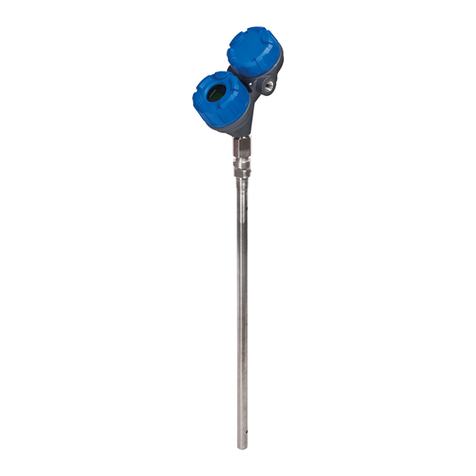
Magnetrol
Magnetrol Kotron 805 series Installation and operating manual
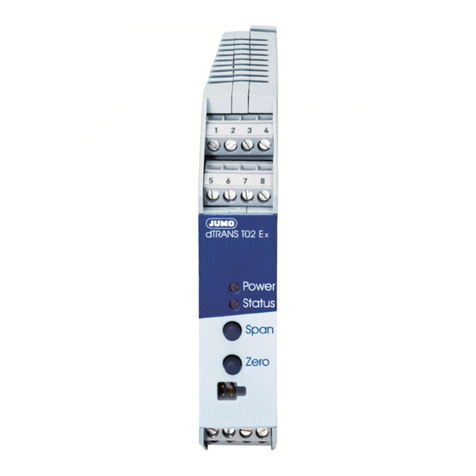
JUMO
JUMO dTRANS T02 Ex operating instructions
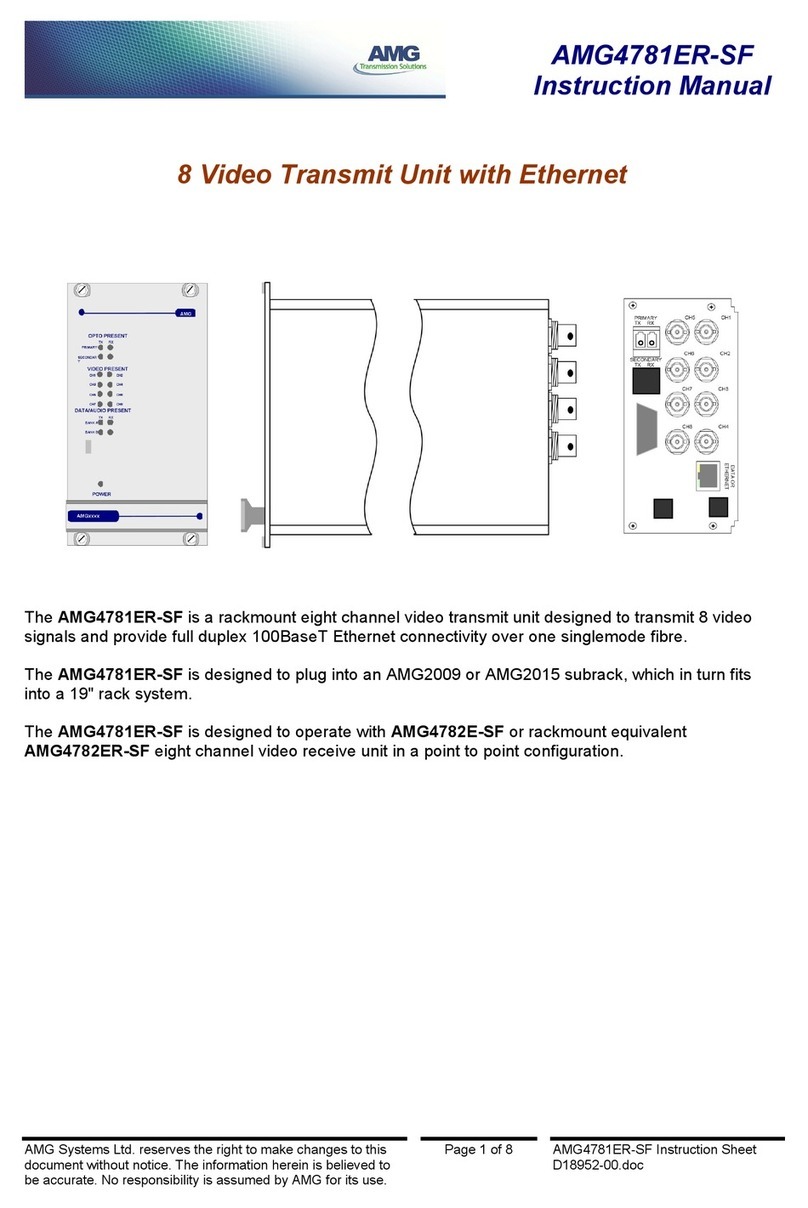
AMG
AMG AMG4781ER-SF instruction manual
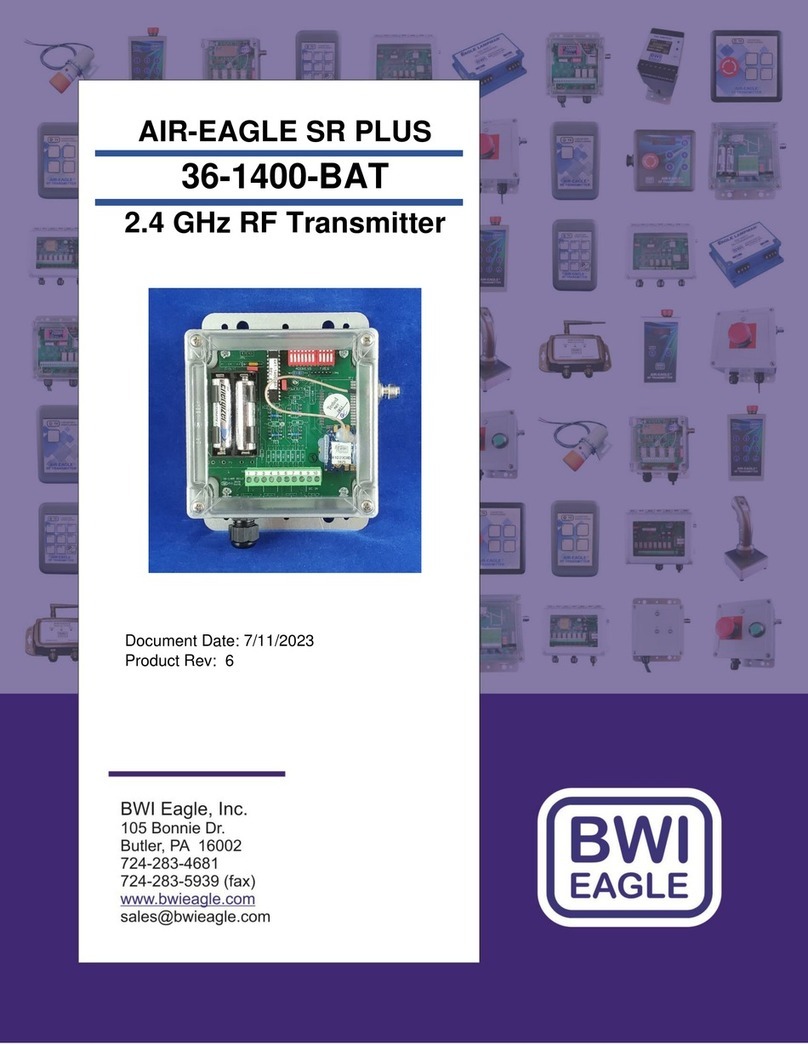
BWI Eagle
BWI Eagle 36-1400-BAT manual
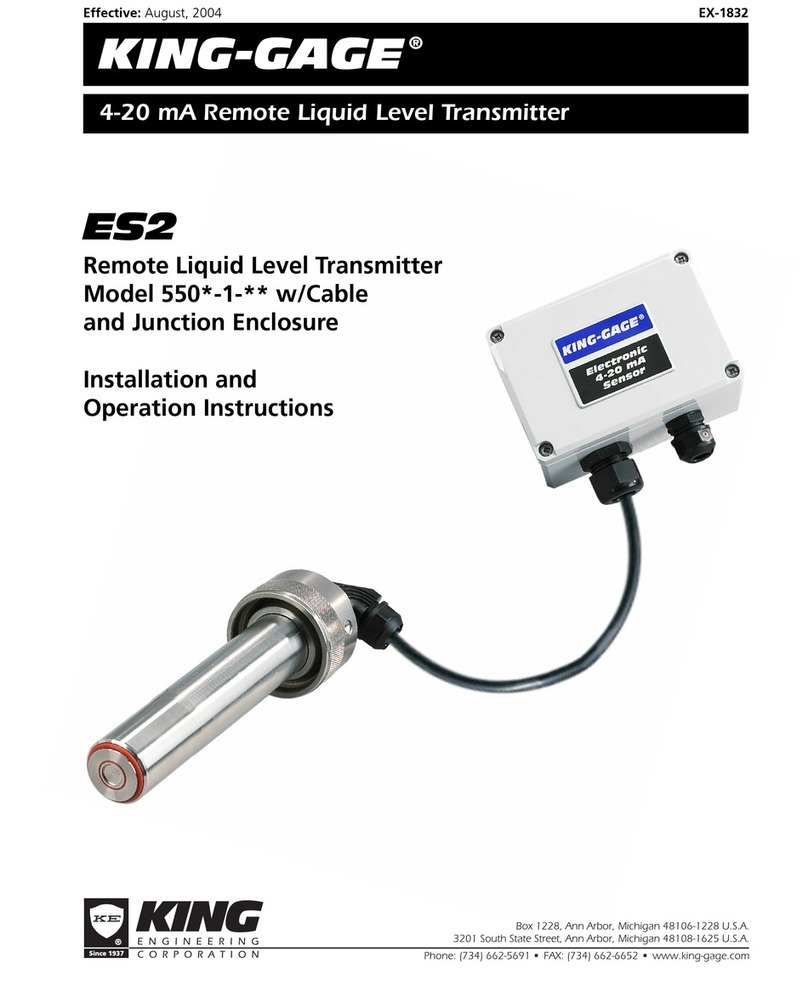
King-Gage
King-Gage ES2 550*-1 Series Installation and operation instructions

CVW
CVW BeamLink-Lite quick start guide
